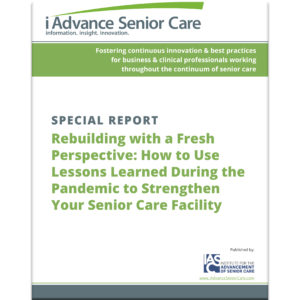Support Your Staff’s Mental Health Amidst Pandemic Fatigue

Susan Harrington, LPC-S, LMFT-S
As the COVID-19 pandemic extends past two years, those working in the senior care industry have been exposed to a tremendous amount of stress. While society’s overall focus might be on moving forward, it’s more important than ever that senior care facilities find ways to continue to support staff mental health.
How Ongoing Pandemic Stress Affects Staff
Susan Harrington, LPC-S, LMFT-S, and founder of Maison Vie New Orleans, is hearing similar sentiments from both people in medical professions and those involved in education: They’re reconsidering their careers.
“Both of those careers are a dedication, and they require a certain personality,” notes Harrington. “The impact of the stress is pretty clear, and it’s not only affecting the nurses, it’s also affecting CNAs, the kitchen staff, and more. It’s people who deal with the public, and with residents.”
Harrington explains that fear may also be contributing to the desire that staff have to leave the medical industry. Some wonder about how their job could impact their family, and the potential of bringing COVID-19 home to a family is an intimidating prospect.
Long-term stress can have physiological effects, too. Harrington notes that someone suffering from ongoing stress might experience weight loss or gain, as well as possible hair loss. Irritability, depression, and anxiety may also occur.
It’s important to recognize that the unique model of a senior care facility means that staff are exposed to increased emotional exhaustion. “There’s a difference between hospital nurses and senior care nurses,” says Harrington. “Senior care has a different meaning because the residents are there every day, rather than staying for a week and then going home.” That ongoing relationship that caregivers develop with residents can increase their emotional exhaustion.
Signs to Watch for in Staff
With ongoing stress taking a toll on staff mental health, supervisory staff in senior care facilities have the opportunity to recognize signs that indicate that staff are struggling. Harrington says that staff in need of mental health support may appear to be exhausted, and they may walk into work not looking forward to the day. Their work performance might suffer, too.
There may also be changes in how staff approach their work, particularly when it comes to decision-making and following procedures. “When their anxiety is at an all-time high, they’re just a little more cautious about making sure things are done according to protocol,” explains Harrington. “They don’t want to be responsible for something happening.”
How Senior Care Facilities Can Support Staff Mental Health
Luckily, there are many ways that facilities can take an active role in supporting staff mental health. Harrington notes that insurance benefits can provide staff with employee assistance program services, and facilities can support the use of these services. Providing staff with financial support and morale boosters, like gift card giveaways, can demonstrate that the facility supports its staff.
Harrington also says that it’s important to offer staff daily support. “Try to have moments where administration come in and say, ‘What can I do to help you today?’” That might be as simple as helping a CNA set up a tray or cart. These simple actions can remind staff that help and support are available, and that the work they’re doing is understood and appreciated.
Facilities might also consider having administrators and directors complete trainings on burnout and compassion fatigue. These trainings can help staff to recognize early signs of burnout, which occurs before compassion fatigue. Recognizing these signs early on means that individuals and teams can recover from burnout faster when they receive the support they need.
Most importantly, remember that staff in the senior care industry are driven by the fact that they care – but that in itself can lead to stress, particularly during the pandemic. “What’s really unique about the medical community is that you can’t pay them to care,” says Harrington. “When you have folks who discern that this is what they want to do for their livelihood, they have care inside of them as a natural trait.” Supporting those caregivers’ mental health and overall wellbeing during this time is key to ensuring that they’re able to continue to pursue that desire to care for others.

Paige Cerulli is a contributing writer to i Advance Senior Care.
Related Articles
Topics: Administration , Featured Articles , Staffing , Training











